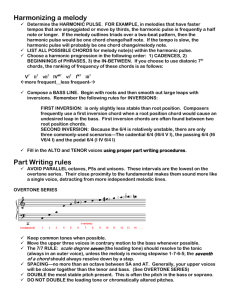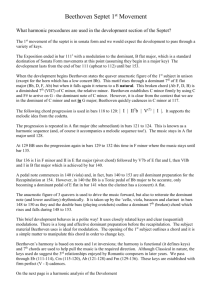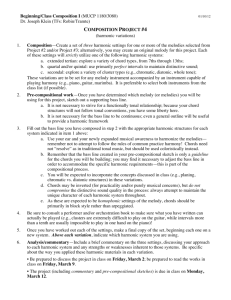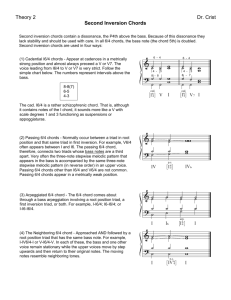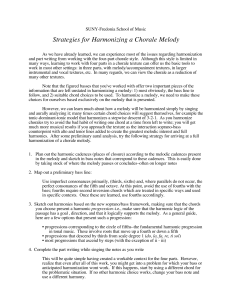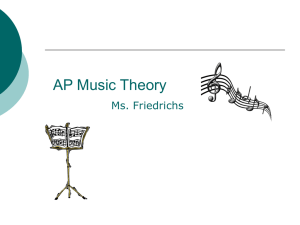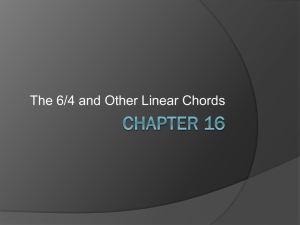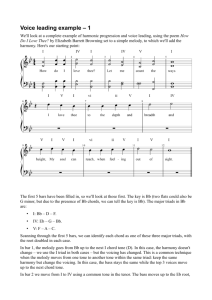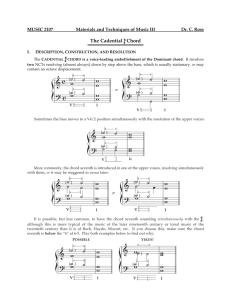Charmony1A09 - Web Page Experience
advertisement
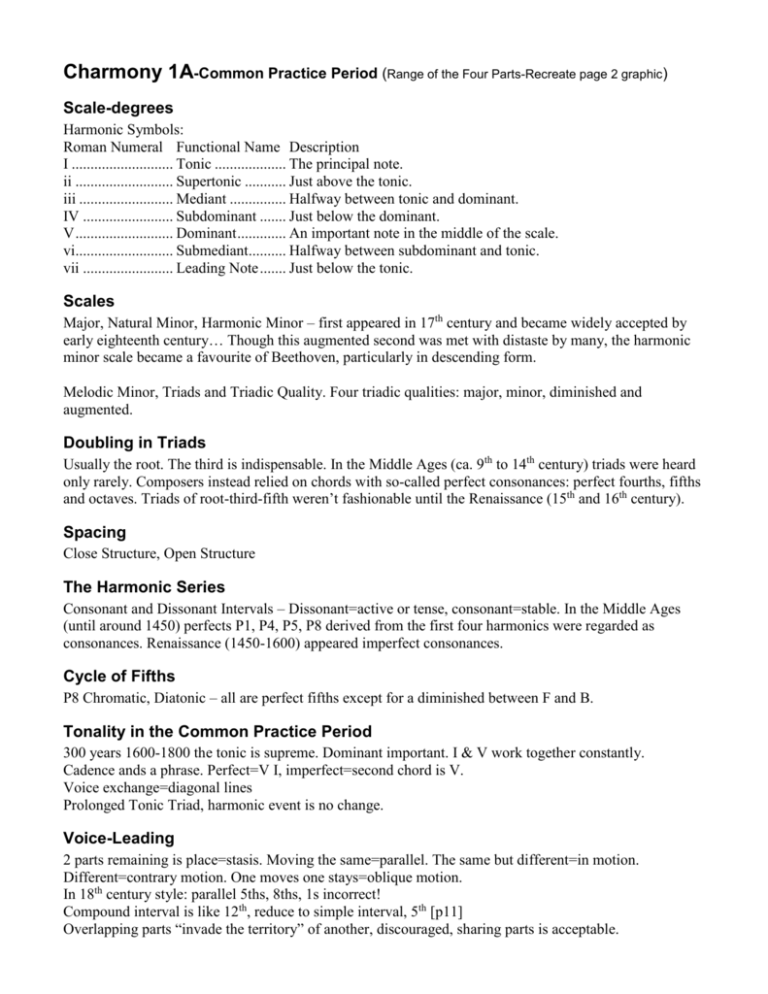
Charmony 1A-Common Practice Period (Range of the Four Parts-Recreate page 2 graphic) Scale-degrees Harmonic Symbols: Roman Numeral Functional Name Description I ........................... Tonic ................... The principal note. ii .......................... Supertonic ........... Just above the tonic. iii ......................... Mediant ............... Halfway between tonic and dominant. IV ........................ Subdominant ....... Just below the dominant. V .......................... Dominant ............. An important note in the middle of the scale. vi.......................... Submediant.......... Halfway between subdominant and tonic. vii ........................ Leading Note ....... Just below the tonic. Scales Major, Natural Minor, Harmonic Minor – first appeared in 17th century and became widely accepted by early eighteenth century… Though this augmented second was met with distaste by many, the harmonic minor scale became a favourite of Beethoven, particularly in descending form. Melodic Minor, Triads and Triadic Quality. Four triadic qualities: major, minor, diminished and augmented. Doubling in Triads Usually the root. The third is indispensable. In the Middle Ages (ca. 9th to 14th century) triads were heard only rarely. Composers instead relied on chords with so-called perfect consonances: perfect fourths, fifths and octaves. Triads of root-third-fifth weren’t fashionable until the Renaissance (15th and 16th century). Spacing Close Structure, Open Structure The Harmonic Series Consonant and Dissonant Intervals – Dissonant=active or tense, consonant=stable. In the Middle Ages (until around 1450) perfects P1, P4, P5, P8 derived from the first four harmonics were regarded as consonances. Renaissance (1450-1600) appeared imperfect consonances. Cycle of Fifths P8 Chromatic, Diatonic – all are perfect fifths except for a diminished between F and B. Tonality in the Common Practice Period 300 years 1600-1800 the tonic is supreme. Dominant important. I & V work together constantly. Cadence ands a phrase. Perfect=V I, imperfect=second chord is V. Voice exchange=diagonal lines Prolonged Tonic Triad, harmonic event is no change. Voice-Leading 2 parts remaining is place=stasis. Moving the same=parallel. The same but different=in motion. Different=contrary motion. One moves one stays=oblique motion. In 18th century style: parallel 5ths, 8ths, 1s incorrect! Compound interval is like 12th, reduce to simple interval, 5th [p11] Overlapping parts “invade the territory” of another, discouraged, sharing parts is acceptable. Scale-degree is number with caret (^) over it. We circle non-chord tones. [p17] the inner parts should move slowly, rhythm of the bass, not soprano. Harmonic Analysis [p19] The Gavotte was a French folk dance usually in 2/2 time; a musette was a special kink of gavotte which suggests the sound of a bagpipe, with a drone bass. The Dominant Triad The ultimate source of I-V-I is the harmonic series, 2nd, 3rd and 4th. Tonic triad is stable, dominant rather active. [p24] In the Middle Ages, perfect fifths P% and octaves P* were regarded as consonant, pleasing. In the 15th&16th centuries, the Renaissance, musical taste transformed. Perfect consonances were replaced by Imperfect ones, 3rds and 6ths. Parallel 5ths and octaves went out, then prohibited in chorale style of 17th&18th centuries. Perfect Cadence has 7^ - 1^ in Soprano I-V-I forms central progression of tonal music, ultimate harmonic background V-I phrase ending=a perfect cadence. In the middle of a phrase it’s in a non-cadential role. [p31]Bachian resolution: Bach often inserts a passing note, 4^ but the key is 7^ drops by a third to 5^ - as opposed to Strict resolution “Tierce de Picardie” a device that appears often in 18th&19th centuries. I-IV-I IV-I in the common practice era much less than the perfect. Non-Chord Tones: The Appoggiatura [p46] Strongly positioned, accented non-chord tones most common are appoggiatura. It creates a momentary dissonance on the strong first beat that moves to its resolution in a consonance on the weaker beat. NCT: The Suspension P47(&63) Basically an appoggiatura but unlike the appoggiatura it is prepared by the same exact note just preceding it. Preparation-suspension-resolution. Most commonly 4-3. Melody Harmonization, 4 parts Prolong each chord as long as you can. For: Harmonic Rhythm, rate of chordal change, try for 1 or 2 per bar. Dominant 7th, Cadential 6/4 chord Baroque=1600-1750. [p54] Voice-leading with tritone, o5 inward, x4 outward. V7 sometimes has no 5th. Complete V7 may resolve to incomplete I, but an incomplete V7 must resolve to a complete I. [p62] Figured Bass Arabic numerals indicate intervals between bass & notes above. [p64] v(864) each with line to (753) to I, often (5) first. P65 unaccented or weakly positioned non-chord tone, the passing note.. “pn.” Supertonic & Submediant Triads [p80] Supertonic in major, always minor, common. In minor keys, diminished, root position is rare! Pre-dominant chord. Often preceded by vi. V-vi The Deceptive Cadence Instead of V-I. [p84] Voice leading vi usually has a doubled 3rd, actually required! Tritone rules the same as V7-I. F/Bin B/Fout. Non-Chord tones: Neighbor-Note (the auxiliary) P85 “a weakly positioned non-chord tone.” mn=main note, un=upper neighbor, ln=lower neighbor. P86 related only to one note, precedes or follows main note, incomplete neighbor note (i.n.) Échappé (éch). Triads in 1st Inversion “6-chords” [p101] Until now only Roman numerals.. now, Arabic numerals added to account for inversion: 6=3rd in the bass The 3 of 6/3 not needed, implied, but 6/4 never abbreviated 5/3 (natural root position) only noted when preceded by inversion. Viio6 “Passing 6 Chord” Often I-viio6-I6 maybe because bass likes to 1-2-3? Also 3-2-1.. p103 shows Upper Neighbor and Incomplete Neighbor???? P105 in (most common pre-dominant chord of all) I-ii6-V-I, doubling triadic third is justified!!! P107 full “Voice-Leading with Passing 6-Chord” p108-9 “Strings of 6-Chords” P110 NCT: Ant(icipation) Antithesis of suspension-chord tone arrives early! “ant.” Inversions of the dominant seventy P123 tritone P124 ech. up to nowhere! “approach=step, departure=3rd change of direction, weak”-syllabus P128 V 4/2 must resolve to I6 V6=6/4, V7 ist inversion=V6/5, 2nd inversion=V4/3, 3rd inversion=V4/2. V#(3 optional) Supertonic Seventh ii7 P140 “..like the 7th of V7, the seventh of ii7 is an active note and is resolved down by a second.” Ii7 in minor=dim m7 or half-dim 7th, ii6/5, ii4/3, ii4/2: p145 “Bach employs I – ii4/2 – V6/5 – 1 repeatedly in The Well Tempered Clavier” P146 NCT: Cambiata (changing-notes) “camb.” Cambiare=to change. in (un) + in (ln) = camb. Example is Chopin Eb Polonaise. Box around u.n. and l.n. with cambiata label. P147 8-8 Root-Quality Chord Symbols P148 cadential 6/4 = dominant triad with 2 nct’s. example E6/4---5/3 (syllabus says “or I6/4---V7”) P149 write two different responses in bars 5-8, identify Perfect, Imperfect, Deceptive or Plagal & key P162 The Mediant. “bass arpeggiation.” P163 Sequences/Cycle of 5ths: I-IV-vii-III-vi-ii-V-I P167 Pedal 6/4 Chord. Cadential 6/4 chord is no a real 6/4, rather dominant with NCT P185 amazingly passing-notely Frühlingsstimmen (Voices of Spring) – J.Strauss Jr. 1825-1899 P188 mind-boggling chr-chromatic NCTs (chr.p.n.), apps in middle, chr-appoggiatura 189 Secondary Dominants: V of V 191 V6 of V = 5^ #4^ 5^ = V, V6/V, V. Often natural 4 not #4. P193 V7 of V and its inversions. P197 10-8 Modulation
